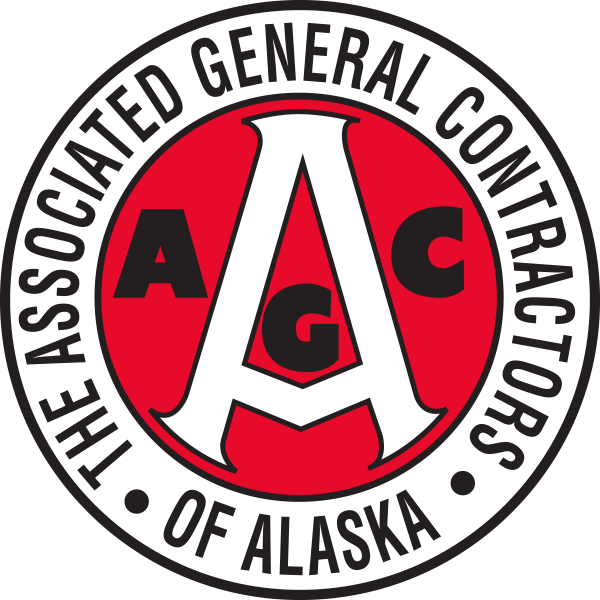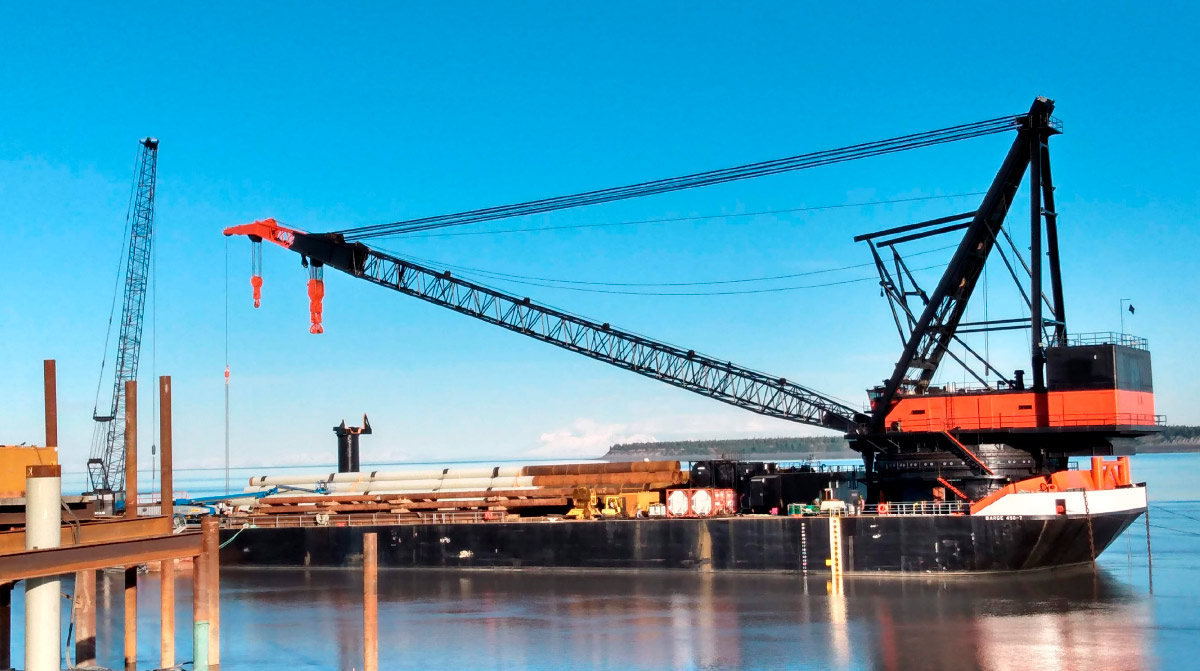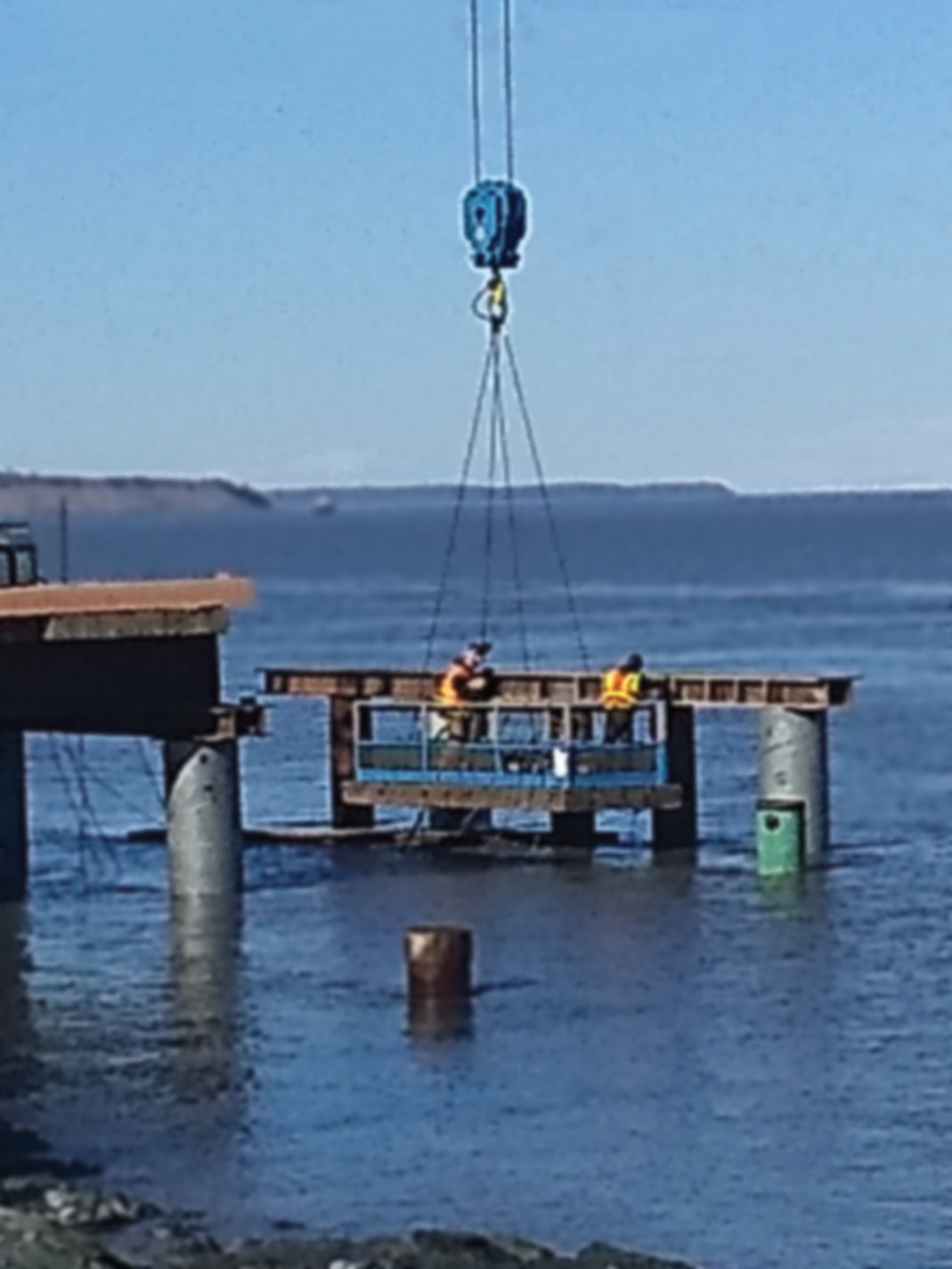

he annual beluga whale migration through Cook Inlet is a highly anticipated event. It is also a critical component of the environmental management efforts for heavy civil and marine contracting company Pacific Pile & Marine (PPM) which is building the Port of Alaska’s new Petroleum and Cement Terminal (PCT).
Federal law prohibits the incidental harassment of marine mammals, which includes any activities that could potentially injure or disrupt their behavioral patterns. Beluga sightings within the vicinity of the areas determined to be influenced by construction activities require a work stoppage to prevent potential harm. To ensure compliance, third-party observers stationed around Cook Inlet sounded the alarm whenever a beluga was spotted during pile-driving activities last spring.
“The acoustical vibration of the piles as during installation causes [the belugas] distress,” says PPM Project Surveyor Sean McCord. “Any sightings shut down our pile driving operations. At times we were down for a half day, and at times a full day, because the whales migrated into Cook Inlet, and then into Ship Creek to look for fish, before coming back into the Inlet to play around for hours.”
PPM accounted for work stoppages due to beluga activity as part of the planning efforts. While this is not an uncommon occurrence, Sharen Walsh, program director for the Port’s modernization project, was nevertheless impressed with PPM’s handling of the temporary disruptions.
“In terms of having something mess with your production that is totally unexpected, they had to stay flexible and adjust their processes to get their production done within those constraints,” she says.
“They performed well with that.”


“From the perspective of the company, they’re not risk-averse,” says Alaska Area Manager Andy Romine. “They’re willing to take risks where other people don’t. It isn’t a matter of risk tolerance. It’s having the experience and discipline to understand the risk and the ingenuity to mitigate through it with constructive solutions. In other words, building a better mouse-trap.”
That willingness to take risks is why Romine believes PPM was the sole bidder for the first phase of the Port of Alaska’s new petroleum and cement terminal, the Port’s primary petroleum terminal and Alaska’s sole bulk cement-handling marine terminal. It is a two-phased project to replace the 55-year-old Petroleum Oil Lubricants Terminal 1.
“The dock is a steel pile-supported dock structure with precast concrete pile caps and deck sections with a cast-in-place topping slab,” Romine says. “It was built from two directions. We built the access trestle from the land side using a temporary steel crane trestle for access and built the water side from a barge.”
PPM completed construction of the approach trestle and loading platform both on time and on budget in November 2020.
The Municipality of Anchorage, acting on behalf of the Port of Alaska, awarded PPM the Phase 2 contract in August 2020 requiring installation of 12-foot diameter steel pile. During Phase 2, PPM will install the mechanical and electrical components needed to facilitate fuel delivery and cement transfer, Romine says. The company will also install six mooring and three breasting dolphins, which the ships tie to and lie against, respectively, when docking. The dolphins sit atop 12-foot diameter monopiles, which McCord says will be the largest piles being driven on the West Coast. Pile installation is currently underway.
Another challenge PPM will continue to encounter during Phase 2 is the environmental restrictions of ice and the tide. Cook Inlet boasts the largest tide change in the United States, McCord says, flooding portions of the platform and below the trestle for several hours a day.
“It’s challenging to plan the work because you have to manage the tides,” he explains. “There are certain things you could do only at high tide, and things you needed to do at low tides. From a planning perspective, the crew did a really good job looking at the tides every morning.”
The project has a narrow work window due to ice vacating the project site and returning in winter.
“What I appreciate about Pacific Pile & Marine is their professionalism and their understanding that they need to document the project and unexpected challenges that come up,” Walsh says. “I find them to be professional and they maintain a good atmosphere to work through these situations.”
Logistical challenges are inevitable on any construction project, but PPM excels at taking a partnering approach with their clients and stakeholders and maintaining open lines of communication with the entire project team, attributes clients appreciate.